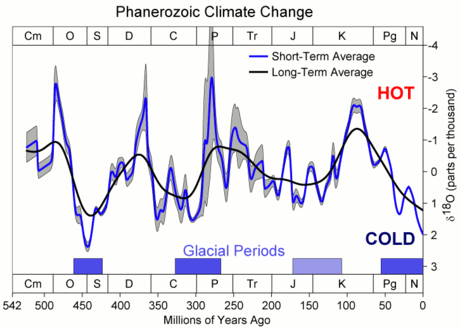Cretaceous Thermal Maximum
The Cretaceous Thermal Maximum (CTM), also known as Cretaceous Thermal Optimum, was a period of climatic warming that reached its peak approximately 90 million years ago (90 Ma) during the Turonian age of the Late Cretaceous epoch. The CTM is notable for its dramatic increase in global temperatures characterized by high carbon dioxide levels.

Characteristics
During the Cretaceous Thermal Maximum (CTM), atmospheric carbon dioxide levels rose to over 1000 parts per million compared to the pre-industrial average of 280 ppm. Rising carbon dioxide resulted in a significant increase in the greenhouse effect, leading to elevated global temperatures.[1] In the seas, crystalline or "glassy" foraminifera predominated, a key indicator of higher temperatures.[2] The CTM began during the Cenomanian/Turonian transition and was associated with a major disruption in global climate as well as global anoxia during Oceanic Anoxic Event 2 (OAE-2).[3] The CTM was the most extreme disruption of the carbon cycle in the past 100 million years.[2][4]
Geological Causes
From 250 to 150 Ma, Pangaea covered the Earth's surface, forming one super continent and one gargantuan ocean. During the breakup of Pangaea from 150 to 130 Ma, the Atlantic Ocean began to form the "Atlantic Gateway".[5] Geological records from both the Deep Sea Drilling Project (DSDP) and the Ocean Drilling Program (ODP) support the enhancement of the CTM by the rifting of the Atlantic Ocean. Rising atmospheric carbon dioxide is thought to have been enhanced by the changing geography of the oceans.[4] While rising carbon dioxide levels caused increased global warming, the climate models of the Cretaceous period do not show such elevated global temperatures due to the Earth's carbon dioxide variations. Geologic records show evidence of dissociation of methane clathrates, which causes a rise in carbon dioxide, as the oxygen gas in the atmosphere will readily combine with the dissociated carbon atom from methane.[6]
Progression with Time
Measurements of the ratio of stable oxygen isotopes in samples of calcite from foraminifera from sediment cores show gradual warming starting in the Albian period and leading to the interval of peak warmth in the Turonian[7] followed by a gradual cooling of surface temperatures to the end of the Maastrichitan age.[8] During the Turonian, several pronounced but relatively short-lived cooler intervals punctuate the otherwise remarkably stable interval of extreme warmth.
Impact
Late Cenomanian sea surface temperatures in the equatorial Atlantic Ocean were substantially warmer than today (~27-29°C).[2] They are estimated to have been ~33°C, but may have been as high as 36°C.[9] Rapid tropical sea surface temperature changes occurred during the CTM.[2] High global temperatures contributed to diversification of terrestrial species during the Cretaceous Terrestrial Revolution and also led to warm stratified oceans during the Oceanic Anoxic Event 2 (OAE-2).[10]

See also
References
- Rothman, Daniel H. (2002-04-02). "Atmospheric carbon dioxide levels for the last 500 million years". Proceedings of the National Academy of Sciences. 99 (7): 4167–4171. Bibcode:2002PNAS...99.4167R. doi:10.1073/pnas.022055499. ISSN 0027-8424. PMC 123620. PMID 11904360.
- Foster, A., et al. "The Cretaceous Thermal Maximum and Oceanic Anoxic Event 2 in the Tropics: Sea- Surface Temperature and Stable Organic Carbon Isotopic Records from the Equatorial Atlantic." American Geophysical Union, Fall Meeting 2006. The Smithsonian/NASA Astrophysics Data System. Web. 20 Oct. 2009. <http://adsabs.harvard.edu/abs/2006AGUFMPP33C..04F>
- Norris, Richard (2018). "Cretaceous Thermal Maximum ~85-90 Ma." Scripps Institution of Oceanography. Accessed 20 September 2018. http://scrippsscholars.ucsd.edu/rnorris/book/cretaceous-thermal-maximum-85-90-ma
- Poulsen, Christopher J., Andrew S. Gendaszek, and Robert L. Jacob. "Did the rifting of the Atlantic Ocean cause the Cretaceous thermal maximum?" Geology 31.2 (2003): 115-118. Web. 20 Oct. 2009. <http://geology.geoscienceworld.org/cgi/content/abstract/31/2/115>.
- Pucéat, Emmanuelle; Lécuyer, Christophe; Sheppard, Simon M. F.; Dromart, Gilles; Reboulet, Stéphane; Grandjean, Patricia (2003-05-03). "Thermal evolution of Cretaceous Tethyan marine waters inferred from oxygen isotope composition of fish tooth enamels". Paleoceanography. 18 (2): 1029. Bibcode:2003PalOc..18.1029P. doi:10.1029/2002pa000823. ISSN 0883-8305.
- Jahren, A. Hope; Arens, Nan Crystal; Sarmiento, Gustavo; Guerrero, Javier; Amundson, Ronald (2001). "Terrestrial record of methane hydrate dissociation in the Early Cretaceous". Geology. 29 (2): 159–162. Bibcode:2001Geo....29..159J. doi:10.1130/0091-7613(2001)029<0159:TROMHD>2.0.CO;2. ISSN 0091-7613.
- Clarke, Leon J.; Jenkyns, Hugh C. (1999). "New oxygen isotope evidence for long-term Cretaceous climatic change in the Southern Hemisphere". Geology. 27 (8): 699–702. Bibcode:1999Geo....27..699C. doi:10.1130/0091-7613(1999)027<0699:NOIEFL>2.3.CO;2. ISSN 0091-7613.
- Huber, Brian T.; Hodell, David A.; Hamilton, Christopher P. (October 1995). "Middle–Late Cretaceous climate of the southern high latitudes: Stable isotopic evidence for minimal equator-to-pole thermal gradients". Geological Society of America Bulletin. 107 (10): 1164–1191. Bibcode:1995GSAB..107.1164H. doi:10.1130/0016-7606(1995)107<1164:MLCCOT>2.3.CO;2. ISSN 0016-7606.
- Wilson, Paul A., Richard D. Norris, and Matthew J. Cooper. "Testing the Cretaceous greenhouse hypothesis using glassy foraminiferal calcite from the core of the Turonian tropics on Demerara Rise." Geology 30.7 (2002):607-610. Web. Oct.2009.<http://geology.geoscienceworld.org/cgi/content/abstract/30/7/607>.
- McInerney, Francesca A.; Wing, Scott L. (2011-05-30). "The Paleocene-Eocene Thermal Maximum: A Perturbation of Carbon Cycle, Climate, and Biosphere with Implications for the Future". Annual Review of Earth and Planetary Sciences. 39 (1): 489–516. Bibcode:2011AREPS..39..489M. doi:10.1146/annurev-earth-040610-133431. ISSN 0084-6597.